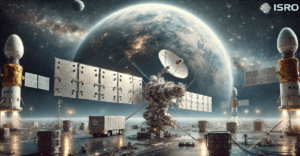ISRO’s SpaDeX Success Marks Key Step Towards Future Space Missions and Human Spaceflight
India’s ISRO successfully completed its Space Docking Experiment (SpaDeX), de-docking its SDX-01 and SDX-02 satellites. This achievement highlights India’s expertise in spacecraft docking, positioning the country for ambitious projects like the Bharatiya Antariksha Station, Chandrayaan-4, and Gaganyaan. ISRO’s success, supported by Prime Minister Modi, makes India the fourth nation to demonstrate this technology. SpaDeX is crucial for satellite servicing, space station operations, and future missions, including human spaceflight and lunar sample returns.

ISRO’s SpaDeX Success Marks Key Step Towards Future Space Missions and Human Spaceflight
India has reached a significant milestone in space technology by successfully completing the de-docking of its Space Docking Experiment (SpaDeX) satellites. This achievement is a major step forward for the country’s future space missions. The Indian Space Research Organisation (ISRO) carried out this complex operation on Thursday, showcasing India’s growing expertise in spacecraft docking and separation. This success highlights the nation’s progress in advanced space technologies.
Union Minister of State for Science & Technology, Mr. Jitendra Singh, congratulated the ISRO team and described this achievement as a moment of pride for all Indians. He emphasized that this accomplishment paves the way for ambitious projects like the Bharatiya Antariksha Station (India’s planned space station), Chandrayaan-4 (India’s next lunar mission), and Gaganyaan (India’s first human spaceflight mission). Mr. Singh also acknowledged Prime Minister Narendra Modi for his consistent support of the scientific community, which has been instrumental in driving these advancements.
The de-docking process involved separating two satellites, SDX-01 (Chaser) and SDX-02 (Target), which were launched on December 30, 2024, using the Polar Satellite Launch Vehicle (PSLV)-C60. The launch took place from the Satish Dhawan Space Centre in Sriharikota. After being launched, the two satellites successfully docked on January 16, 2025. With this achievement, India joined an elite group of nations—China, Russia, and the United States—that have mastered the technology of spacecraft docking and de-docking. This places India among the leading countries in space exploration.
The SpaDeX project was developed by ISRO’s UR Rao Satellite Centre, with contributions from other ISRO centers. It demonstrates India’s capabilities in spacecraft rendezvous, docking, and undocking—technologies that are essential for various space missions. These capabilities are crucial for tasks such as satellite servicing, operating space stations, and conducting human spaceflight missions. They also play a key role in missions like returning lunar samples to Earth.
The successful de-docking of the SpaDeX satellites is a testament to the hard work and dedication of ISRO scientists and engineers. It reflects India’s commitment to advancing its space program and exploring new frontiers in space technology. This achievement not only boosts India’s reputation in the global space community but also opens up new possibilities for future missions.
The SpaDeX project is a significant step toward realizing India’s long-term goals in space exploration. For instance, the Bharatiya Antariksha Station, India’s planned space station, will require advanced docking and undocking capabilities. Similarly, the Gaganyaan mission, which aims to send Indian astronauts to space, will rely on these technologies to ensure the safety and success of the crew. Additionally, missions like Chandrayaan-4, which will focus on lunar exploration, will benefit from the expertise gained through projects like SpaDeX.
This achievement also highlights the importance of collaboration and innovation in space research. ISRO’s ability to develop and execute such complex missions demonstrates the strength of India’s scientific and technological capabilities. It also underscores the role of government support in fostering innovation and achieving breakthroughs in space technology.
In conclusion, the successful de-docking of the SpaDeX satellites is a landmark achievement for India’s space program. It showcases the country’s growing expertise in advanced space technologies and sets the stage for future missions. With projects like the Bharatiya Antariksha Station, Chandrayaan-4, and Gaganyaan on the horizon, India is well on its way to becoming a global leader in space exploration. This accomplishment is a source of pride for the nation and a testament to the hard work and vision of ISRO and the Indian scientific community.
You must be logged in to post a comment.